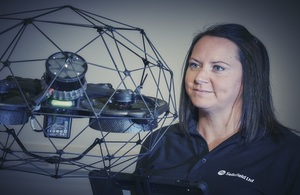Sellafield high flier urges girls to reach for the skies
Drone expert Amanda Smith marked International Women's Day by representing the UK at a global technology conference

Amanda Smith
She explained to delegates at an industry summit in Switzerland how Sellafield is deploying unmanned aerial vehicles (UAVs) to deliver decommissioning work safer, faster, and more cost-effectively.
Amanda hopes her career journey will inspire other young women to consider a career in this rapidly growing sector.
She said:
I would like to see more women coming into the profession. Women are still few and far between in the drone world.
I think we need to engage women and girls in primary school so they know they can do these types of jobs.
You don’t need to have a degree to have a career in the drone industry. I am proof of that.
You need to understand how things work, have a good grasp of maths, English and the sciences, and be a good communicator. Everything else is about attitude and a willingness to learn.
Amanda joined Sellafield Ltd as an apprentice after deciding against a career in her original choices of accountancy or business.
She was offered a place to study accountancy at Newcastle University but didn’t take it up. She then enrolled on a business course at Carlisle College but left after six weeks.
Wondering what to do next, she took a part-time job in a supermarket while considering her options.
She finally decided to join the Sellafield Ltd as a technical assistant testing instruments. There was an early sign of her promise when she won the Apprentice of the Year award in 2006.
But female apprentices were much more of a rarity in those days and Amanda was already juggling family life with her work and studies.
She said:
I knew I had to do well.
While the lads were coming out of school and college aged 16 and 18, I was already married with a 12-month-old daughter.
I was also starting to do a college course as well as the job. I had a lot on my plate but I was determined to make a go of it.
Today she manages a team of equipment engineers and is responsible for a 16-strong team of response and emergency duty drone pilots.
She’s a passionate advocate of using technology to support people in their jobs.
At the Lausanne conference, she described the rapid rate of progress in the deployment of UAVs in the nuclear industry.
She added:
The change I have seen in five years you would not believe.
We’ve taken the number of drone flights at Sellafield from one flight every six months to 200 flights a year.
Who knows where drones could be in another five years’ time? By 2029 we could be seeing fully autonomous flights.
I remember when I was a young girl and watching Tomorrow’s World on television and seeing these amazing robots and innovations.
It always seemed to be the Japanese who were leading the way. So as a girl I thought these things only happened and were only possible in Japan.
Last year we hosted a visit from Japan at Sellafield’s Engineering Centre of Excellence where they came to see us and were amazed at what we were doing.
We are at the forefront of drone developments now and it’s super exciting.